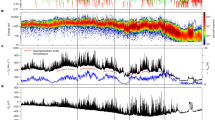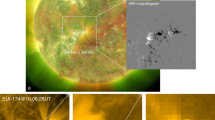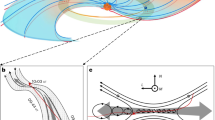Abstract
Magnetic reconnection is the process by which magnetic field lines of opposite polarity reconfigure to a lower-energy state, with the release of magnetic energy to the surroundings. Reconnection at the Earth's dayside magnetopause and in the magnetotail allows the solar wind into the magnetosphere1,2. It begins in a small ‘diffusion region’, where a kink in the newly reconnected lines produces jets of plasma away from the region. Although plasma jets from reconnection have previously been reported3,4,5,6,7, the physical processes that underlie jet formation have remained poorly understood because of the scarcity of in situ observations of the minuscule diffusion region. Theoretically, both resistive and collisionless processes can initiate reconnection8,9,10,11,12,13,14, but which process dominates in the magnetosphere is still debated. Here we report the serendipitous encounter of the Wind spacecraft with an active reconnection diffusion region, in which are detected key processes predicted by models8,9,10,11,12,13 of collisionless reconnection. The data therefore demonstrate that collisionless reconnection occurs in the magnetotail.
This is a preview of subscription content, access via your institution
Access options
Subscribe to this journal
Receive 51 print issues and online access
$199.00 per year
only $3.90 per issue
Buy this article
- Purchase on Springer Link
- Instant access to full article PDF
Prices may be subject to local taxes which are calculated during checkout



Similar content being viewed by others
References
Dungey, J. W. Interplanetary magnetic field and the auroral zones. Phys. Rev. Lett. 6, 47–48 (1961).
Cowley, S. W. H. in Magnetic Reconnection in Space and Laboratory Plasmas (ed. Hones, E. W.) 375–378 (Geophysics Monograph 30, American Geophysical Union, Washington DC, 1984).
Paschmann, G. et al. Plasma acceleration at the Earth's magnetopause: Evidence for reconnection. Nature 282, 243–246 (1979).
Sonnerup, B. U. Ö. et al. Evidence for reconnection at the earth's magnetopause. J. Geophys. Res. 86, 10049–10067 (1981).
Gosling, J. T., Thomsen, M. F., Bame, S. J. & Russell, C. T. Accelerated plasma flows at the near-tail magnetopause. J. Geophys. Res. 91, 3029–3041 (1986).
Phan, T. D. et al. Extended magnetic reconnection at the earth's magnetopause from detection of bi-directional jets. Nature 404, 848–850 (2000).
Øieroset, M., Phan, T. D., Lin, R. P. & Sonnerup, B. U. Ö. Walén and variance analyses of high-speed flows observed by Wind in the midtail plasma sheet: Evidence for reconnection. J. Geophys. Res. 105, 25247–25263 (2000).
Sonnerup, B. U. Ö. in Solar System Plasma Physics, Vol. III (eds Lanzerotti, L. T., Kennel, C. F. & Parker, E. N.) 45–108 (North-Holland, New York, 1979).
Shay, M. A., Drake, J. F., Rogers, B. N. & Denton, R. E. Alfvénic collisionless magnetic reconnection and the Hall term. J. Geophys. Res. 106, 3759–3772 (2001).
Ma, Z. W. & Bhattacharjee, A. Hall magnetohydrodynamic reconnection: The Geospace Environment Modeling challenge. J. Geophys. Res. 106, 3773–3782 (2001).
Hesse, M., Birn, J. & Kuznetsova, M. Collisionless magnetic reconnection: Electron processes and transport modeling. J. Geophys. Res. 106, 3721–3735 (2001).
Pritchett, P. L. Geospace Environment Modeling magnetic reconnection challenge: Simulations with a full particle electromagnetic code. J. Geophys. Res. 106, 3783–3798 (2001).
Birn, J. et al. Geospace Environmental Modeling (GEM) magnetic reconnection challenge. J. Geophys. Res. 106, 3715–3719 (2001).
Vasyliunas, V. M. Theoretical models of magnetic field line merging. I. Rev. Geophys. Space Phys. 13, 303–336 (1975).
Coroniti, F. V. & Eviatar, A. Magnetic field reconnection in collisionless plasma. Astrophys. Suppl. 33, 189–210 (1977).
Cattell, C. et al. ISEE-1 and Geotail observations of low frequency waves at the magnetopause. J. Geophys. Res. 100, 11823–11829 (1995).
Sibeck, D. G. et al. in Magnetospheric Plasma Sources and Losses Ch. 5 (eds Hultqvist, B. et al.) 207–283 (Space Sciences Series of ISSI 6, Kluwer Academic, Dordrecht, 1999).
Shay, M. A., Drake, J. F., Rogers, B. N. & Denton, R. E. The scaling of collisionless, magnetic reconnection for large systems. Geophys. Res. Lett. 26, 2163–2166 (1999).
Fujimoto, M. et al. Observations of earthward streaming electrons at the trailing boundary of a plasmoid. Geophys. Res. Lett. 24, 2893–2896 (1997).
Hoshino, M., Mukai, T., Yamamoto, T. & Kokubun, S. Ion dynamics in magnetic reconnection: Comparison between numerical simulations and Geotail observations. J. Geophys. Res. 103, 4509–4530 (1998).
Nagai, T. et al. Geotail observations of the Hall current system. Evidence of magnetic reconnection in the magnetotail. J. Geophys. Res. (in the press).
Deng, X. H. & Matsumoto, H. Rapid magnetic reconnection in the Earth's magnetosphere generated by whistler waves. Nature 410, 557–559 (2001).
Terasawa, T. Hall current effect on tearing mode instability. Geophys. Res. Lett. 10, 475–478 (1983).
Wang, X., Bhattacharjee, A. & Ma, Z. W. Collisionless reconnection: Effects of Hall current and electron pressure gradient. J. Geophys. Res. 105, 27633–27648 (2000).
Goodrich, C. C., Lyon, J. G., Wiltberger, M., Lopez, R. E. & Papadopoulos, K. An overview of the impact of the January 10–11, 1997, magnetic cloud on the magnetosphere via global MHD simulations. Geophys. Res. Lett. 25, 2537–2540 (1998).
Raeder, J. Modeling the magnetosphere for northward interplanetary magnetic field: Effects of electrical resistivity. J. Geophys. Res. 104, 17357–17368 (1999).
Gombosi, T. I., DeZeeuw, D. L., Groth, C. P. T., Powell, K. G. & Song, P. in Physics Space Plasmas Vol. 15 (eds Chang, T. & Jasperse, J. R.) 121–128 (MIT Press, Cambridge, Massachusetts, 1998).
Sonnerup, B. U. Ö. & Cahill, L. J. Magnetopause structure and attitude from Explorer 12 observations. J. Geophys. Res. 72, 171–183 (1967).
Acknowledgements
We thank S. Bale, C. Chaston, B. Sonnerup, J. Drake and A. Bhattacharjee for discussions and T. Nagai for providing a preprint of his Geotail manuscript at an early stage. This work is supported by grants from NASA.
Author information
Authors and Affiliations
Corresponding author
Rights and permissions
About this article
Cite this article
Øieroset, M., Phan, T., Fujimoto, M. et al. In situ detection of collisionless reconnection in the Earth's magnetotail. Nature 412, 414–417 (2001). https://doi.org/10.1038/35086520
Received:
Accepted:
Issue Date:
DOI: https://doi.org/10.1038/35086520
This article is cited by
-
First observation of fluid-like eddy-dominant bursty bulk flow turbulence in the Earth’s tail plasma sheet
Scientific Reports (2023)
-
Magnetotail plasma eruptions driven by magnetic reconnection and kinetic instabilities
Nature Geoscience (2023)
-
Recent progress on magnetic reconnection by in situ measurements
Reviews of Modern Plasma Physics (2023)
-
Kinetic Alfven wave (KAW) eigenmode in magnetosphere magnetic reconnection
Reviews of Modern Plasma Physics (2022)
-
Current Sheets, Plasmoids and Flux Ropes in the Heliosphere
Space Science Reviews (2021)
Comments
By submitting a comment you agree to abide by our Terms and Community Guidelines. If you find something abusive or that does not comply with our terms or guidelines please flag it as inappropriate.



